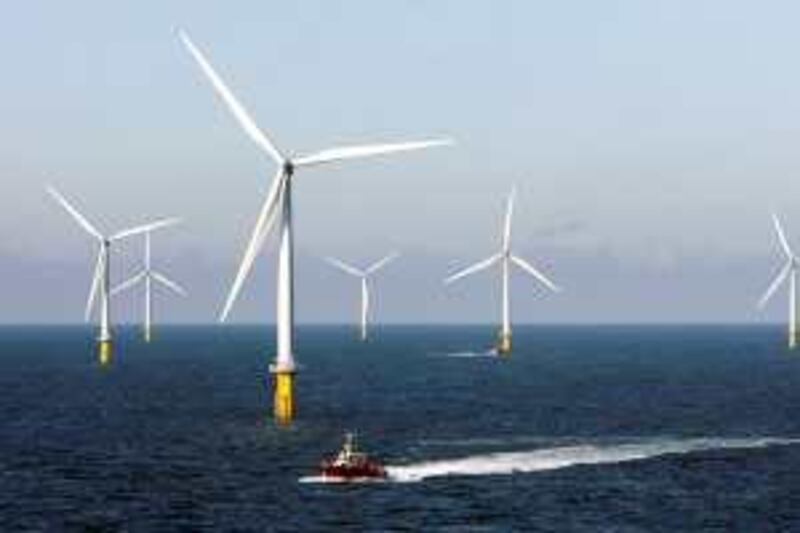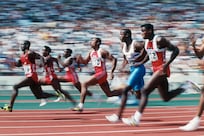The blades of the 70-metre-tall wind turbines turn gracefully as a strong breeze blows over the North Sea. We are 14km off the west coast of Denmark, and as our ship passes, row upon row of the bright-white structures appear on the ocean.
Horns Rev is one of the world's largest offshore wind parks, producing 160 megawatts (mw) at full capacity. That is enough power to supply 150,000 homes for a year, or 2 per cent of Denmark's total electricity demand. The Nordic country believes in wind power. About 20 per cent of its electricity is produced this way, more than any country in the world. And the proportion is on the increase: Denmark aims to generate 30 per cent of its energy needs from renewable sources by 2020, up from 18 per cent today.
"Wind power will cover about half of the growth," says Lars Aagaard, the managing director of the Danish Energy Association. The Danes are busy working towards this target. A few kilometres from Horns Rev, Horns Rev 2, the world's largest offshore wind park, opened last month. Its 91 turbines produce up to 209mw. And it's not over. Denmark plans to build an even bigger wind park in the Baltic Sea. The Kriegers Flak project would combine three wind parks, shared by Germany, Sweden and Denmark, and could produce up to 1,800mw. The decision to go ahead is expected in December.
Denmark has been developing wind power since the oil shocks of the 1970s exposed an over-reliance on hydrocarbon imports. Financing for the then-nascent wind sector was provided in the form of subsidies and loan guarantees. Utility companies were mandated to buy wind energy at a preferential price, guaranteeing a customer base for the new energy industry. High energy taxes were put in place and the revenues helped finance research and development in clean technology.
Almost 40 per cent of the wind power capacity installed globally has been supplied by Danish manufacturers, with Vestas, a home-grown firm, the market leader. The industry accounted for 23,500 direct jobs at home in 2007, while clean-technology industries as a whole accounted for 6.5 per cent of Denmark's total exports that year. "Today, despite the crisis, this is one of our fastest-rowing exports," says Connie Hedegaard, Denmark's minister for climate and energy. "So what started as something we asked companies and households to do, that could have been perceived as restrictions, turned out to be a huge advantage. It forced industries in Denmark to be first movers with new technologies."
The policy helped the Danes to reach some high environmental goals, too. Between 1990 and 2006, they reduced their carbon emissions by 14 per cent, while enjoying GDP growth in real terms of 43 per cent and an increase in energy consumption of just 5 per cent. But developing wind power has not always been plain sailing. Horns Rev was the world's most ambitious offshore wind park when it was planned in the late 1990s. It turned out to be an expensive learning curve for Vestas.
"We underestimated the challenges of working offshore - in one of the most aggressive wind regimes in the world," says Ditlev Engel, the chief executive of Vestas. Soon after production started, all the equipment had to be replaced because the wind was too strong. The cost was ?38 million (Dh209.2m). "We have learnt a lot of from it," says Mr Engel. Challenges remain. Turbines corrode faster at sea because of the salty, humid environment, and changing major components offshore is more costly than onshore. The further away the turbines are from land, the greater the cost of cables to transmit the energy and the more expensive the maintenance of the cables.
"Our experience is that even if you are as close to shore as 10km, it is already pretty far away, from an operational point of view," says Mr Engel. Also, the site has high exposure to the rough weather of the North Sea. When waves are high, the turbines can be reached only by helicopter. During the frequent winter storms, the turbines cannot be reached at all. Onshore wind turbines therefore remain the most attractive option, at least from an operational perspective. But local politicians often fight government plans to establish wind parks in their backyard. Even in Denmark, where wind turbines dot the country, there is little public support for new onshore projects.
"Neighbours don't like having wind turbines," says Mr Aagaard. "So today, the only way to go is offshore." Vestas would like to see more forceful action from governments on this challenge. Mr Engel thinks the market demands a move away from the small-scale, "one-man, one-turbine" model. "The reality is that we are going to have big wind parks," he says. "The governments need to go in and say, 'In this area, it makes more sense to put turbines as there are good wind resources'. Instead, they say, 'Let's see if somebody can agree to have a turbine here'."
It is not enough to build wind turbines, however. The electrical grid also needs to be made more flexible and to be connected to other countries' power grids. Wind power is not constant: it is generated only when the wind blows, and there is so far no cost-effective way to store it. So, when the wind is not blowing, Denmark has to import expenwsive hydropower or nuclear-generated electricity from Norway and Sweden. But when the wind does blow, Denmark becomes an exporter of cheap, wind-generated power back to its neighbours.
Changing the electricity source happens at the flick of a switch. But it was a "huge challenge" to integrate wind into a grid that was dominated by 16 fossil-fuel power-generating stations, says Peder Andreasen, the chief executive of Energinet.dk, which runs Denmark's national grid. And despite all of Denmark's progress in promoting green energy, its future still relies heavily on non-renewables. In 2020, even if Denmark reaches its 30 per cent renewables target, 65 per cent of its energy will still come from coal-fired power plants. These plants may be some of the most energy-efficient in the EU, but coal will still be a dirty source of energy.
But the Danes are not discouraged. Theirs is one of few countries to have achieved so much with renewables. They believe it is how they will create growth and jobs in the future. "Our focus - on renewable solutions has created an export adventure," says Ms Hedegaard. @Email:business@thenational.ae





